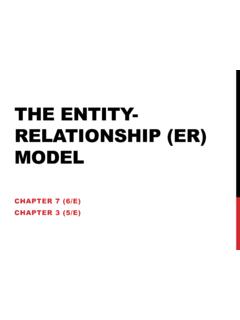Transcription of Distributed Database Management Systems
1 Distributed Database Management Systems Outline Introduction Distributed DBMS Architecture Distributed Database Design Distributed Query Processing Distributed Concurrency Control Distributed Reliability Protocols Distributed DBMS 2. Page 1. Outline Introduction What is a Distributed DBMS. Problems Current state-of-affairs Distributed DBMS Architecture Distributed Database Design Distributed Query Processing Distributed Concurrency Control Distributed Reliability Protocols Distributed DBMS 3. Motivation Database Computer Technology Networ ks integration distribution Distributed Database Systems integration integration centralization Distributed DBMS 4. Page 2. What is a Distributed Database System? A Distributed Database (DDB) is a collection of multiple, logically interrelated databases Distributed over a computer network.
2 A Distributed Database Management system (D DBMS) is the software that manages the DDB and provides an access mechanism that makes this distribution transparent to the users. Distributed Database system (DDBS) = DDB + D DBMS. Distributed DBMS 5. What is not a DDBS? A timesharing computer system A loosely or tightly coupled multiprocessor system A Database system which resides at one of the nodes of a network of computers - this is a centralized Database on a network node Distributed DBMS 6. Page 3. Centralized DBMS on a Network Site 1. Site 2. Site 5. Communication Network Site 4 Site 3. Distributed DBMS 7. Distributed DBMS Environment Site 1. Site 2. Site 5. Communication Network Site 4 Site 3. Distributed DBMS 8.
3 Page 4. Implicit Assumptions Data stored at a number of sites each site logically consists of a single processor. Processors at different sites are interconnected by a computer network no multiprocessors parallel Database Systems Distributed Database is a Database , not a collection of files data logically related as exhibited in the users' access patterns relational data model D-DBMS is a full-fledged DBMS. not remote file system, not a TP system Distributed DBMS 9. Distributed DBMS Promises Transparent Management of Distributed , fragmented, and replicated data Improved reliability/availability through Distributed transactions Improved performance Easier and more economical system expansion Distributed DBMS 10.
4 Page 5. Transparency Transparency is the separation of the higher level semantics of a system from the lower level implementation issues. Fundamental issue is to provide data independence in the Distributed environment Network (distribution) transparency Replication transparency Fragmentation transparency horizontal fragmentation: selection vertical fragmentation: projection hybrid Distributed DBMS 11. Example EMP ASG. ENO ENAME TITLE ENO PNO RESP DUR. E1 J. Doe Elect. Eng. E1 P1 Manager 12. E2 M. Smith Syst. Anal. E2 P1 Analyst 24. E3 A. Lee Mech. Eng. E2 P2 Analyst 6. E4 J. Miller Programmer E3 P3 Consultant 10. E5 B. Casey Syst. Anal. E3 P4 Engineer 48. E6 L. Chu Elect. Eng. E4 P2 Programmer 18. E7 R. Davis Mech.
5 Eng. E5 P2 Manager 24. E8 J. Jones Syst. Anal. E6 P4 Manager 48. E7 P3 Engineer 36. E7 P5 Engineer 23. E8 P3 Manager 40. PROJ PAY. PNO PNAME BUDGET TITLE SAL. P1 Instrumentation 150000 Elect. Eng. 40000. P2 Database Develop. 135000 Syst. Anal. 34000. P3 CAD/CAM 250000 Mech. Eng. 27000. P4 Maintenance 310000 Programmer 24000. Distributed DBMS 12. Page 6. Transparent Access SELECT ENAME,SAL. Tokyo FROM EMP,ASG,PAY. WHERE DUR > 12. Boston Paris AND = Paris projects AND = Paris employees Communication Paris assignments Network Boston employees Boston projects Boston employees Boston assignments Montreal New Montreal projects York Paris projects Boston projects New York projects New York employees with budget > 200000.
6 New York projects Montreal employees New York assignments Montreal assignments Distributed DBMS 13. Distributed Database . User View Distributed Database Distributed DBMS 14. Page 7. Distributed DBMS - Reality User Query DBMS. Software User Application DBMS. Software DBMS Communication Software Subsystem User DBMS User Application Software Query DBMS. Software User Query Distributed DBMS 15. Potentially Improved Performance Proximity of data to its points of use Requires some support for fragmentation and replication Parallelism in execution Inter-query parallelism Intra-query parallelism Distributed DBMS 16. Page 8. Parallelism Requirements Have as much of the data required by each application at the site where the application executes Full replication How about updates?
7 Updates to replicated data requires implementation of Distributed concurrency control and commit protocols Distributed DBMS 17. System Expansion Issue is Database scaling Emergence of microprocessor and workstation technologies Demise of Grosh's law Client-server model of computing Data communication cost vs telecommunication cost Distributed DBMS 18. Page 9. Distributed DBMS Issues Distributed Database Design how to distribute the Database replicated & non-replicated Database distribution a related problem in directory Management Query Processing convert user transactions to data manipulation instructions optimization problem min{cost = data transmission + local processing}. general formulation is NP-hard Distributed DBMS 19.
8 Distributed DBMS Issues Concurrency Control synchronization of concurrent accesses consistency and isolation of transactions' effects deadlock Management Reliability how to make the system resilient to failures atomicity and durability Distributed DBMS 20. Page 10. Relationship Between Issues Directory Management Query Distribution Reliability Processing Design Concurrency Control Deadlock Management Distributed DBMS 21. Outline Introduction Distributed DBMS Architecture Distributed Database Design Fragmentation Data Placement Distributed Query Processing Distributed Concurrency Control Distributed Reliability Protocols Distributed DBMS 22. Page 11. Design Problem In the general setting : Making decisions about the placement of data and programs across the sites of a computer network as well as possibly designing the network itself.
9 In Distributed DBMS, the placement of applications entails placement of the Distributed DBMS software; and placement of the applications that run on the Database Distributed DBMS 23. Distribution Design Top-down mostly in designing Systems from scratch mostly in homogeneous Systems Bottom-up when the databases already exist at a number of sites Distributed DBMS 24. Page 12. Top-Down Design Requirements Analysis Objectives User Input Conceptual View Integration View Design Design Access GCS Information ES's Distribution Design User Input LCS's Physical Design LIS's Distributed DBMS 25. Distribution Design Issues Why fragment at all? How to fragment? How much to fragment? How to test correctness? How to allocate?
10 Information requirements? Distributed DBMS 26. Page 13. Fragmentation Can't we just distribute relations? What is a reasonable unit of distribution? relation views are subsets of relations locality extra communication fragments of relations (sub-relations). concurrent execution of a number of transactions that access different portions of a relation views that cannot be defined on a single fragment will require extra processing semantic data control (especially integrity enforcement). more difficult Distributed DBMS 27. Fragmentation alternatives . Horizontal PROJ. PROJ1 : projects with budgets less PNO PNAME BUDGET LOC. than $200,000 P1 Instrumentation 150000 Montreal P2 Database Develop. 135000 New York P3 CAD/CAM 250000 New New York PROJ2 : projects with budgets P4 Maintenance 310000 Paris York greater than or equal to P5 CAD/CAM 500000 Boston $200,000.














